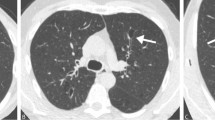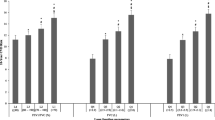Abstract
Objective
The objective of this study was to investigate the association of spirometry and pulmonary CT biomarkers with cardiovascular events.
Methods
In this lung cancer screening trial 3,080 male participants without a prior cardiovascular event were analysed. Fatal and non-fatal cardiovascular events were included. Spirometry included forced expiratory volume measured in units of one-second percent predicted (FEV1%predicted) and FEV1 divided by forced vital capacity (FVC; FEV1/FVC). CT examinations were quantified for coronary artery calcium volume, pulmonary emphysema (perc15) and bronchial wall thickness (pi10). Data were analysed via a Cox proportional hazard analysis, net reclassification improvement (NRI) and C-indices.
Results
184 participants experienced a cardiovascular event during a median follow-up of 2.9 years. Age, pack-years and smoking status adjusted hazard ratios were 0.992 (95 % confidence interval (CI) 0.985-0.999) for FEV1%predicted, 1.000 (95%CI 0.986-1.015) for FEV1/FVC, 1.014 (95%CI 1.005-1.023) for perc15 per 10 HU, and 1.269 (95%CI 1.024-1.573) for pi10 per 1 mm. The incremental C-index (<0.015) and NRI (<2.8 %) were minimal. Coronary artery calcium volume had a hazard ratio of 1.046 (95%CI 1.034-1.058) per 100 mm3, an increase in C-index of 0.076 and an NRI of 16.9 % (P < 0.0001).
Conclusions
Pulmonary CT biomarkers and spirometry measurements were significantly associated with cardiovascular events, but did not contain clinically relevant independent prognostic information for cardiovascular events.
Key Points
• Pulmonary CT biomarkers and spirometry are associated with cardiovascular events
• These pulmonary measurements do not contain clinically relevant independent prognostic information
• Only coronary calcium score improved cardiovascular risk prediction above age and smoking

Similar content being viewed by others
Abbreviations
- COPD:
-
Chronic obstructive pulmonary disease
- CT:
-
Computed Tomography
- CVD:
-
Cardiovascular disease
- FEV1:
-
Forced expiratory volume in one second (FEV1)
- FEV1%predicted:
-
FEV1 expressed as percent predicted
- FVC:
-
Forced vital capacity
- ICD:
-
International Classification of Diseases
- Perc15:
-
Density of the lungs quantified at the 15th percentile point
- Pi10:
-
Square root of wall area for a theoretical airway with 10-mm lumen perimeter
- ROC:
-
Receiver operating characteristic
References
Mets OM, de Jong PA, Prokop M (2012) Computed tomographic screening for lung cancer: an opportunity to evaluate other diseases. JAMA 308:1433–1434
National Lung Screening Trial Research T, Aberle DR, Adams AM (2011) Reduced lung-cancer mortality with low-dose computed tomographic screening. N Engl J Med 365:395–409
Burns DM (2003) Epidemiology of smoking-induced cardiovascular disease. Prog Cardiovasc Dis 46:11–29
Becker CR (2005) Estimation of cardiac event risk by MDCT. Eur Radiol 15:B17–B22
Vliegenthart R, Oudkerk M, Hofman A et al (2005) Coronary calcification improves cardiovascular risk prediction in the elderly. Circulation 112:572–577
Mets OM, Vliegenthart R, Gondrie MJ et al (2013) Lung Cancer Screening CT-Based Prediction of Cardiovascular Events. JACC Cardiovasc Imaging 6:899–907
Xie X, Zhao Y, de Bock GH et al (2013) Validation and Prognosis of Coronary Artery Calcium Scoring inNon-Triggered Thoracic Computed Tomography: Systematic Review and Meta-Analysis. Circ Cardiovasc Imaging 6:514–521
Wouters EF (2005) Local and systemic inflammation in chronic obstructive pulmonary disease. Proc Am Thorac Soc 2:26–33
Stone IS, Barnes NC, Petersen SE (2012) Chronic obstructive pulmonary disease: a modifiable risk factor for cardiovascular disease? Heart 98:1055–1062
Bellomi M, Rampinelli C, Veronesi G et al (2010) Evolution of emphysema in relation to smoking. Eur Radiol 20:286–292
Sin DD, Man SF (2003) Why are patients with chronic obstructive pulmonary disease at increased risk of cardiovascular diseases? The potential role of systemic inflammation in chronic obstructive pulmonary disease. Circulation 107:1514–1519
Mets OM, Murphy K, Zanen P et al (2012) The relationship between lung function impairment and quantitative computed tomography in chronic obstructive pulmonary disease. Eur Radiol 22:120–128
Mohamed Hoesein FA, de Hoop B, Zanen P et al (2011) CT-quantified emphysema in male heavy smokers: association with lung function decline. Thorax 66:782–787
Nakano Y, Wong JC, de Jong PA et al (2005) The prediction of small airway dimensions using computed tomography. Am J Respir Crit Care Med 171:142–146
Camiciottoli G, Cavigli E, Grassi L et al (2009) Prevalence and correlates of pulmonary emphysema in smokers and former smokers. A densitometric study of participants in the ITALUNG trial. Eur Radiol 19:58–66
Schroeder EB, Welch VL, Couper D et al (2003) Lung function and incident coronary heart disease: the Atherosclerosis Risk in Communities Study. Am J Epidemiol 158:1171–1181
Stavem K, Aaser E, Sandvik L et al (2005) Lung function, smoking and mortality in a 26-year follow-up of healthy middle-aged males. Eur Respir J 25:618–625
Hole DJ, Watt GC, Davey-Smith G, Hart CL, Gillis CR, Hawthorne VM (1996) Impaired lung function and mortality risk in men and women: findings from the Renfrew and Paisley prospective population study. BMJ 313:711–715, discussion 715-716
Johnston AK, Mannino DM, Hagan GW, Davis KJ, Kiri VA (2008) Relationship between lung function impairment and incidence or recurrence of cardiovascular events in a middle-aged cohort. Thorax 63:599–605
Sverzellati N, Cademartiri F, Bravi F et al (2012) Relationship and prognostic value of modified coronary artery calcium score, FEV1, and emphysema in lung cancer screening population: the MILD trial. Radiology 262:460–467
Tockman MS, Pearson JD, Fleg JL et al (1995) Rapid decline in FEV1. A new risk factor for coronary heart disease mortality. Am J Respir Crit Care Med 151:390–398
Ryan G, Knuiman MW, Divitini ML, James A, Musk AW, Bartholomew HC (1999) Decline in lung function and mortality: the Busselton Health Study. J Epidemiol Community Health 53:230–234
Iwamoto H, Yokoyama A, Kitahara Y et al (2009) Airflow limitation in smokers is associated with subclinical atherosclerosis. Am J Respir Crit Care Med 179:35–40
van den Bergh KA, Essink-Bot ML, Borsboom GJ et al (2010) Short-term health-related quality of life consequences in a lung cancer CT screening trial (NELSON). Br J Cancer 102:27–34
Miller MR, Crapo R, Hankinson J et al (2005) General considerations for lung function testing. Eur Respir J 26:153–161
van Rikxoort EM, de Hoop B, Viergever MA, Prokop M, van Ginneken B (2009) Automatic lung segmentation from thoracic computed tomography scans using a hybrid approach with error detection. Med Phys 36:2934–2947
Dirksen A (2008) Monitoring the progress of emphysema by repeat computed tomography scans with focus on noise reduction. Proc Am Thorac Soc 5:925–928
Quanjer PH, Tammeling GJ, Cotes JE, Pedersen OF, Peslin R, Yernault JC (1993) Lung volumes and forced ventilatory flows. Report Working Party Standardization of Lung Function Tests, European Community for Steel and Coal. Official Statement of the European Respiratory Society. Eur Respir J Suppl 16:5–40
Mets OM, Schmidt M, Buckens CF et al (2013) Diagnosis of chronic obstructive pulmonary disease in lung cancer screening Computed Tomography scans: independent contribution of emphysema, air trapping and bronchial wall thickening. Respir Res 14:59
Isgum I, Prokop M, Niemeijer M, Viergever MA, van Ginneken B (2012) Automatic coronary calcium scoring in low-dose chest computed tomography. IEEE Trans Med Imaging 31:2322–2334
Tromp M, Ravelli AC, Bonsel GJ, Hasman A, Reitsma JB (2011) Results from simulated data sets: probabilistic record linkage outperforms deterministic record linkage. J Clin Epidemiol 64:565–572
Pencina MJ, D'Agostino RB Sr, D'Agostino RB Jr, Vasan RS (2008) Evaluating the added predictive ability of a new marker: from area under the ROC curve to reclassification and beyond. Stat Med 27:157–172, discussion 207-112
de Jong PA, Gondrie MJ, Buckens CF et al (2011) Prediction of cardiovascular events by using non-vascular findings on routine chest CT. PLoS One 6:e26036
Vanfleteren LE, Spruit MA, Groenen M et al (2013) Clusters of comorbidities based on validated objective measurements and systemic inflammation in patients with chronic obstructive pulmonary disease. Am J Respir Crit Care Med 187:728–735
Sin DD, Anthonisen NR, Soriano JB, Agusti AG (2006) Mortality in COPD: Role of comorbidities. Eur Respir J 28:1245–1257
Jacobs PC, Gondrie MJ, van der Graaf Y et al (2012) Coronary artery calcium can predict all-cause mortality and cardiovascular events on low-dose CT screening for lung cancer. AJR Am J Roentgenol 198:505–511
Polonsky TS, McClelland RL, Jorgensen NW et al (2010) Coronary artery calcium score and risk classification for coronary heart disease prediction. JAMA 303:1610–1616
Acknowledgments
The scientific guarantor of this publication is Pim A. de Jong. The authors of this manuscript declare relationships with the following companies: HJ de Koning received money for being on the Member Advisory Board of Roche Diagnostics. This study has received funding by: The Netherlands Organisation for Health Research and Development (ZonMw); the Dutch Cancer Society; and the Koningin Wilhelmina Fonds; Stichting Centraal Fonds Reserves van Voormalig Vrijwillige Ziekenfondsverzekeringen (RVVZ); Siemens Germany (provided 4 digital workstations and LungCARE for the performance of 3D measurements); Rotterdam Oncologic Thoracic Steering Committee; and the G. Ph. Verhagen Trust, Flemish League Against Cancer, Foundation Against Cancer, and Erasmus Trust Fund. One of the authors has significant statistical expertise. Institutional Review Board approval was obtained. Written informed consent was obtained from all subjects (patients) in this study.
Some study subjects or cohorts have been previously reported. This study is an ancillary study of a large lung cancer screening RCT (NELSON Study; ISRCTN63545820).
Methodology: prospective, prognostic study (original study was a randomised lung cancer screening trial), multi-center study.
Author information
Authors and Affiliations
Corresponding author
Rights and permissions
About this article
Cite this article
Takx, R.A.P., Vliegenthart, R., Hoesein, F.A.A.M. et al. Pulmonary function and CT biomarkers as risk factors for cardiovascular events in male lung cancer screening participants: the NELSON study. Eur Radiol 25, 65–71 (2015). https://doi.org/10.1007/s00330-014-3384-6
Received:
Revised:
Accepted:
Published:
Issue Date:
DOI: https://doi.org/10.1007/s00330-014-3384-6




